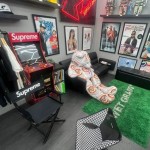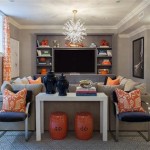How to Decorate the Large Wall Behind a Couch
The expanse of a large wall behind a couch presents both a challenge and an opportunity for interior design. The space offers an expansive canvas to inject personality, establish a focal point, and enhance the overall aesthetic of a living room. However, improperly decorated, a large wall can feel cold, empty, and even overwhelming. Successfully transforming this significant surface requires careful consideration of the room's existing elements, the desired mood, and the scale of the available options. This guide provides a comprehensive overview of techniques and considerations for effectively decorating the large wall space behind a couch.
Assessing the Room and Identifying Key Features
Before beginning any decorating project, a thorough assessment of the room’s existing features is crucial. This involves observing the color palette, the style of furniture, the amount of natural light, and the existing textures and patterns. Note whether the room's design leans towards modern, traditional, minimalist, or eclectic. Identify the dominant color scheme; does it consist of warm or cool tones? These observations will guide the selection of artwork, mirrors, shelving, and other decorative elements, ensuring the new additions complement the existing environment rather than clashing with it. Pay particular attention to the size of the couch itself. A large couch will often necessitate a larger-scale design on the wall to maintain visual balance. Consider the viewing distance from the couch to the wall. Objects placed farther away should be larger and bolder in order to be easily seen.
Considering Scale and Proportion
Scale and proportion are paramount when decorating a large wall. The elements chosen should relate harmoniously to the size of the wall and the couch. For example, a small collection of artwork will look lost on a vast surface. Conversely, an oversized piece of art may dominate the space and overwhelm the seating area. The height of the ceiling and the width of the wall itself must be taken into account. A tall, narrow wall benefits from vertical elements, while a wider wall may be better suited to horizontal arrangements or large, single pieces. Utilizing design principles such as the rule of thirds can assist with visual balance. The goal is to create a visual weight that is neither too heavy nor too light, keeping the space feeling balanced and appealing.
Selecting the Right Decor Elements
Several decor elements can effectively transform the wall behind a couch. The specific choice of elements depends on the overall design scheme and personal preferences. One of the most popular options is artwork. Large-scale paintings, photographic prints, or posters can create a stunning focal point. Another option is to use multiple pieces of artwork, arranged in a gallery wall format. Mirrors can enhance the feeling of space and reflect light, making the room appear brighter and more open. Sculptural elements, such as wall-mounted sculptures or metal panels, can add textural interest and visual depth. Floating shelves provide both decorative and functional benefits, offering a place to display plants, books, and other collectibles. Textiles, such as tapestries or fabric panels, can introduce color, pattern, and texture, while also absorbing sound. Combining several of these elements can create a layered and personalized look.
Arranging Artwork and Gallery Walls
When utilizing artwork, careful consideration should be given to the arrangement. When selecting art for behind the couch, the first step involves identifying the colors already present in the space. Choose artwork that complements or contrasts with these colors to create harmony or visual interest. For a single, large piece of art, it is often best to center it above the couch. The width of the artwork should be approximately two-thirds to three-fourths the width of the couch to achieve proper balance. Gallery walls offer more flexibility and opportunity for personalization. When creating a gallery wall, experiment with different arrangements before committing to a final layout. Consider using paper templates to simulate the size and position of each piece. The spacing between individual pieces is also important, and it typically involves using consistent spacing to create a cohesive appearance. Maintain enough space to avoid visual clutter. Finally, consider incorporating varying frame styles, colors, and sizes to create more visual interest. For particularly challenging spaces, consider drawing on professional design tools or consulting with an interior designer to see how the artwork would appear in your wall with a virtual mock-up.
Incorporating Shelving and Storage Solutions
Floating shelves can transform a blank wall into a functional and attractive space. They can be used alone or in combination with other decorative elements. Consider the depth and length of the shelves based on the items that will be displayed. A small shelf can be used to display books, plants, and other decorative objects. Consider using shelves of varying heights and lengths to create visual interest. When installing shelves, ensure they are securely mounted to the wall. Consider shelving units that provide closed storage, which may be useful for concealing unsightly devices and other items. Shelving can also be utilized to showcase photographs and other precious keepsakes. This approach provides a balance between function and aesthetics, adding depth and personality to the space.
Lighting Considerations
Lighting is crucial for enhancing the decorative elements on the wall behind the couch. Ambient lighting, such as recessed lights or overhead fixtures, provides general illumination. Task lighting, such as the use of a floor lamp beside the couch, can provide more localized illumination. Accent lighting, such as spotlights that shine directly on artwork or wall-mounted sconces, can highlight specific features and create visual drama. The type of lighting selected should complement the overall design scheme and the style of the decorative elements. Consider the use of dimmers to adjust the light level and create different moods. Smart lighting systems can be used to conveniently control the lights, with color-changing bulbs adding another layer of customization. The strategic placement of lighting can significantly improve the room's overall ambiance and highlight the artwork or shelves.

20 Ideas For Designing Behind The Living Room Sofa

It Seems To Always Be A Conundrum Myself Included For What Do With The Huge And Blank Wall Beh Behind Sofa Couch Shelves Living Room

From Blah To Fantastic 7 Ways Style The Wall Behind Sofa Michael Helwig Interiors

What To Hang On The Wall Over Your Sofa Closetful Of Clothes

40 Awesome Over The Sofa Wall Decor Ideas And Designs For 2025

How To Perfectly Style The Blank Wall Behind Your Sofa Zhush

How To Perfectly Style The Blank Wall Behind Your Sofa Zhush

30 Best Decoration Ideas Above The Sofa For 2025

9 Ideas For That Blank Wall Behind The Sofa Living In A Fixer Upper

How To Perfectly Style The Blank Wall Behind Your Sofa Zhush







